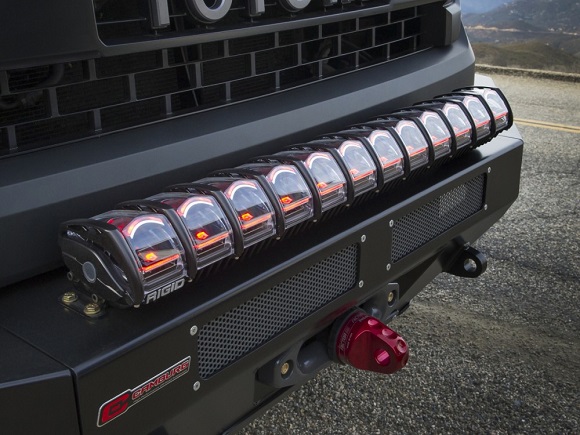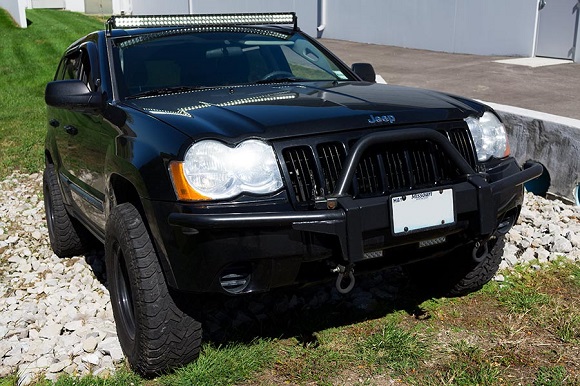Outfitting your 4WD with the correct type and number of lights when heading out into the bush is of the utmost importance. You’re often faced with pitch-black darkness as the sun sets, and navigating your way through such settings can be dangerous with the standard setup you use in the city. Even during the day, it will be hard to spot debris, branches or rocks, never mind animals due to dust or a bad turn of weather. Going prepared means you’ll want a decent set of off-roading lights.
There are several types of lights, each mounted in a different position on the vehicle, and illuminating the path before you in different ways. Driving lights, for instance, emit a narrow spread of light at far distances. They are set low on the 4WD, and work well with the vehicle’s headlights. Combine these with a pair of fog lights and you get a decent balance of flood and spot beams at different distances. To put less strain on batteries, drivers going off-road can instead get decent led bars. Placed higher up, led bars Australia combine flood and spot beams, with excellent spread of light, so you can see everything at close quarters, and more of what lies ahead.
What to Look for in LED Light Bars
LED tech has come a long way in the past decade, and LED arrays are getting smaller and more powerful, while consuming less energy. The first led bars consisted of up to 4 rows of lights, but these have gradually been replaced by smaller units in either single or dual-row bars. Their compact size allows for a wide choice of mounting positions. If combing these with other lights, led bars are often fitted along with roof racks and smaller units along bull bars.
Not all LED light bars are created equal though, despite the leaps and bounds from the first iterations. Things to look for in an off-roading setting are:
- Genuine LED chips from reputed brands. These ensure that the lights get the best possible output, will last the distance, and beam light in optimal colour temperatures easy on the eye. Light output is measured in lumens, with higher numbers in brighter LED arrays. For even spread of available light over a specified area look to the LUX ratings. A typical 22-inch, dual row led bar will have around 15000 lumens rating, illuminating up to 600 metres down the road.
- Reflector and lens array. LED light bars need to produce a spread of wide light at greater distances. This all depends on how the reflectors inside are positioned to evenly distribute the light. Most LED bars combine flood beams for illuminating areas close up and spot beams for better visibility into the distance. Lens are made of polycarbonate and have UV coatings for added protection.
- Materials and build quality. Since LED bars are mounted high up, they need to be adequately protected from debris, water and dust. Housings are made of aluminium alloys able to wick off rocks in typical off-roading scenarios. This also dissipates heat buildup to ensure optimal performance and longevity. IP 67 ratings and above mean led bars Australia will last in heavy downpours and dust storms.
- Sizing. LED light bars are available in different sizes and can be combined to get the output you need. Smaller, single row arrays come in at 12 inches, while the largest dual row setups will cover most of the roof at 42 inches, or well over a metre. Mounting brackets and sliders allow them to be mounted in different locations on the car.
Benefits of LED Light Bars
Compared to traditional halogens and HID lights, LED light arrays have several advantages that make them especially useful off-road.
- They consume less electricity. LEDs are high on output, and low on consumption. You won’t be draining the battery as much as with xenons or halogens. This also allows you to match several LED bars across the vehicle.
- They offer the best combination of beams. Until recently you had to get separate flood and spot beams. Switching between both isn’t always an option and having them both on saps the battery. LED light bars are a better solution that illuminates well into the distance and with a wider spread of light.
- LEDs are safer. Since the diodes don’t get as hot as bulbs do, there’s no risk of high heat causing trouble. LEDs run cooler, and this also allows LED light bars to outlive traditional driving or fog lights. In addition, there’s no gas involved and no burst bulbs. This makes them an environmentally-friendly option too.
- Better Build. Along with the advancements in getting more light out of LED diodes, builders are also focusing their efforts in making better housings to last in different environments. LEDs and LED light bars may be an investment, but it’s one that will last without the usual hassle of other lighting types.
Possibly the only downside is remembering to switch them off when heading back to sealed roads and urban settings. They produce intense light and can blind oncoming drivers. Get 4WD LED light bars from dedicated 4WD or auto lighting suppliers.


